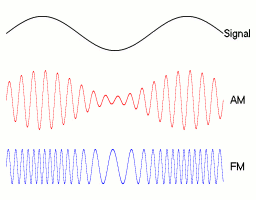
RANDOM PAGE
SITE SEARCH
LOG
IN
SIGN UP
HELP
To gain access to revision questions, please sign up and log in.
A2
aSignals
To transmit signals, it is necessary to convert, encode or modulate the signal into a form of energy that will travel through copper cables, fibre optics or free space.
bRadio Signals in Free Space
- To transmit and receive radio signals, an antenna is needed.
- The ideal size for an antenna is half a wavelength long.
- Antennas longer than a few hundred metres are too big to be practicable. This sets a lower limit on the range of easily useable frequencies.
- Antennas smaller than around a millimetre are hard to make. This sets an upper limit on the range of frequencies that can be used easily.
cInformation Signals
- Information signals are often at a low frequency. For example Audio covers the range from 20 to 20 000Hz.
- At 20 000 Hz, the radio wavelength would equal C / F = 3x108 / 20000 = 15 kilometres. This is much too long to be transmitted using an antenna of a reasonable size. The solution is to use a carrier wave with a much shorter wavelength.
dCarrier Waves
- The carrier wave is a radio frequency signal at a frequency chosen such that the size of the antenna is convenient.
- FM broadcast radio uses the 100MHz band.
This choice was not by chance.
The wavelength is 3 metres and a half wave antenna is 1.5 metres long.
The quarter wave 75cm antenna is just right to mount on a car and work efficiently.
This makes VHF FM car radio convenient.
- On its own, the carrier contains no information.
- The carrier has to be modified to allow the information signal to be sent. This is called MODULATION.
eModulation
- The carrier wave is modified in a manner that is proportional to the information signal.
- AM - The amplitude of the carrier is modified.

- FM - The frequency of the carrier is modified.
- There are several digital modulation methods. These achieve the same goal without the disadvantages of analogue AM and FM.
reviseOmatic V3
Contacts, ©, Cookies, Data Protection and Disclaimers
Hosted at linode.com, London


